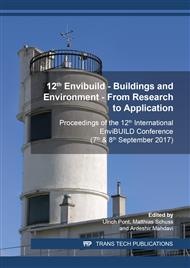[1]
J. Kang, K. Chourmouziadou, K. Sakantamis, B. Wang, Y. Hao (Eds.), COST Action TD0804: Soundscape of European Cities and Landscapes, COST, Oxford, (2013).
Google Scholar
[2]
J. Kang, B. Schulte-Fortkamp (Eds.), Soundscape and the Built Environment, Taylor & Francis, Florida, (2016).
Google Scholar
[3]
M. Soyer, C. Houdet, Reduction of acoustic annoyance in school dining halls, The Journal of Auditory Research 26 (1986) 191-196.
Google Scholar
[4]
A. Astolfi, M. Filippi, Good acoustical quality in restaurants: a compromise between speech intelligibility and privacy, Proceedings of ICA, Kyoto, (2004).
Google Scholar
[5]
J. Kang, Acoustic quality in non-acoustic public buildings. Technical Acoustics 25-6 (2006) 513-522.
Google Scholar
[6]
M. Hodgson, Z. Razavi, G. Steininger, Evaluation of acoustical environments in eating establishments, Building Acoustics 16-2 (2009) 125-148.
DOI: 10.1260/135101009788913239
Google Scholar
[7]
J. H. Rindel, Acoustical capacity as a means of noise control in eating establishments, BNAM 2012 Joint Baltic-Nordic Acoustics Meeting, Odense, Denmark, (2012).
Google Scholar
[8]
P. L. Battaglia, Achieving acoustical comfort in restaurants, Proceedings of Meetings on Acoustics, 22-015001, (2014).
Google Scholar
[9]
D. Svensson, C. Jeong, J. Brunskog, Acoustic comfort in eating establishments, Forum Acusticum 2014, Krakow, (2014).
Google Scholar
[10]
L. Zelem, V. Chmelik, D. Urban, M. Rychtarikova, Analysis of the acoustic conditions in the student restaurant, Proceedings of EuroNoise 2015, Maastricht (2015) 1627-1631.
Google Scholar
[11]
R. Watson, O. Downey, The Little Red Book of Acoustics, Blue Tree Acoustics, Sheffield, (2008).
Google Scholar
[12]
Z. Razavi, Evaluation and Optimization of Acoustical Environments in Eating Establishments, Master Thesis, The University of Tehran, (2006).
Google Scholar
[13]
H. Lazarus, Prediction of Verbal Communication is Noise— A review: Part 1., Applied Acoustics 19 (1986) 439-464.
DOI: 10.1016/0003-682x(86)90039-3
Google Scholar
[14]
J. H. Rindel, Verbal communication and noise in eating establishments, Applied Acoustics 71 (2010) 1156–1161.
DOI: 10.1016/j.apacoust.2010.07.005
Google Scholar
[15]
International Commission for Acoustics, Psychoacoustic Basis of Sound Quality Evaluation section, Proceedings Book of ICA 2001, Rome, (2001).
Google Scholar
[16]
M. Long, Architectural Acoustics (2nd ed.), Elsevier Academic Press, Oxford, (2014).
Google Scholar
[17]
DIN 45631 Standard, Calculation of loudness level and loudness from the sound spectrum - Zwicker method - Amendment 1: Calculation of the loudness of time-variant sound, German Institute for Standardization, (2010).
Google Scholar
[18]
ISO 532 Standard, Acoustics- Method for calculating loudness level, International Organization for Standardization, (1975).
Google Scholar
[19]
ISO 532 Standard Draft, Acoustics- Methods for calculating loudness, International Organization for Standardization, (2016).
Google Scholar
[20]
ANSI / ASA S3.4 Standard, American national standard procedure for the computation of loudness of steady sounds, American National Standards Institute, (2007).
Google Scholar
[21]
H Fastl, E. Zwicker, Psychoacoustics: Facts and Models, (3rd ed.), Springer, New York, (2007).
Google Scholar
[22]
S. S. Stevens, Calculation of the loudness of complex noise, J. Acoust. Soc. Am. 28 (1956) 807-832.
Google Scholar
[23]
B. C. J. Moore, B. R. Glasberg, T. Baer, A model for the prediction of thresholds, loudness and partial loudness. J. Audio Eng. Soc. 45 (1997) 224-240.
Google Scholar
[24]
Information on http://www.bksv.com/library/dictionary.aspx.
Google Scholar
[25]
DIN 45692 Standard, Measurement technique for the simulation of the auditory sensation of sharpness. German Institute for Standardization, (2009).
Google Scholar
[26]
G. Von Bismarck, Sharpness as an attribute of the timbre of steady state sounds, Acustica 30 (1974) 159-172.
Google Scholar
[27]
W. Aures, Berechnungsverfahren für den sensorischen Wohlklang beliebiger Schallsignale (A model for Calculating the Sensory Euphony of Various Sounds) Acustica 59 (1985) 130-141.
Google Scholar
[28]
R. Sottek, Gehörgerechte Rauhigkeitsberechnung, DAGA 94, Dresden, (1994).
Google Scholar
[29]
AMCA Publication 302, Application of sone ratings for non-ducted air moving devices, Air Moving and Conditioning Association, (1973).
Google Scholar
[30]
P. Lindborg, Psychoacoustic, physical, and perceptual features of restaurants: A field survey in Singapore, Applied Acoustics 92 (2015) 47–60.
DOI: 10.1016/j.apacoust.2015.01.002
Google Scholar
[31]
N. M. Ortiz, B. Schulte-Fortkamp, Quiet-zones, is quiet" the correct identifier, in: J. Kang, K. Chourmouziadou, K. Sakantamis, B. Wang, Y. Hao (Eds.), COST Action TD0804: Soundscape of European Cities and Landscapes, COST, Oxford, 2013, pp.68-70.
Google Scholar
[32]
P. N. Dökmeci, F. Aletta, M. Frost, I. Garcia, M. Galuszka, J. Kocinski, H. Lin, A. Mundt, M. Tomas, K. Genuit, B. Schulte-Fortkamp, COST Short term scientific mission: Training course on soundscape analysis: Soundwalk, recordings, analysis and listening tests, in: J. Kang, K. Chourmouziadou, K. Sakantamis, B. Wang, Y. Hao (Eds.), COST Action TD0804: Soundscape of European Cities and Landscapes, COST, Oxford, 2013, pp.224-227.
DOI: 10.1121/1.3384065
Google Scholar
[33]
M. Mehta, J. Johnson, J. Rocafort, Architectural Acoustics: Principles and Design, Prentice Hall, New Jersey, (1999).
Google Scholar
[34]
L. L. Beranek, Music, Acoustics & Architecture, John Wiley and Sons Inc., New York, (1962).
Google Scholar


